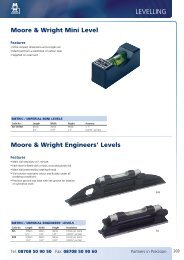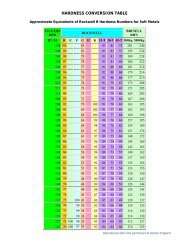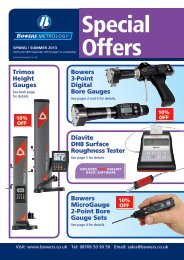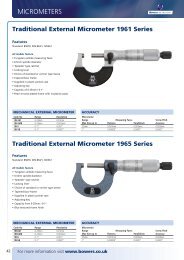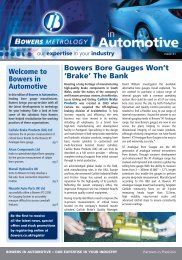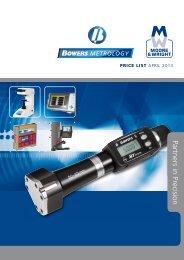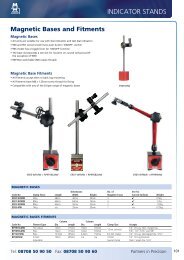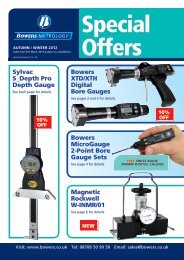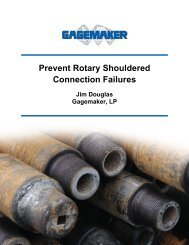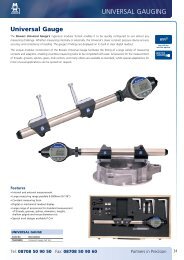XTA Analogue Bore Gauge - Bowers UK
XTA Analogue Bore Gauge - Bowers UK
XTA Analogue Bore Gauge - Bowers UK
Create successful ePaper yourself
Turn your PDF publications into a flip-book with our unique Google optimized e-Paper software.
<strong>Analogue</strong> Internal Micrometer<br />
Operating Instructions<br />
Micromètres d’intérieur<br />
Notice d’Utilisation<br />
Mechanische<br />
Innenmessschrauben<br />
Bedienungsanleitung<br />
Istruzioni d’uso Micrometri per<br />
Interni Analogici Serie<br />
Micrometros de Interiores<br />
Analogicos <strong>Bowers</strong> A<br />
Manual de instrucciones
NOMENCLATURE & SETTING INSTRUCTIONS (METRIC)<br />
HOW TO READ...<br />
All metric micrometers are graduated in 0.005mm divisions. The<br />
sleeve has a datum line, and the thimble is graduated as illustrated<br />
below. The sleeve is graduated in 0.5mm divisions and one complete<br />
revolution of the thimble is equal to 0.5mm. To read the instrument,<br />
read the size on the sleeve to obtain the nearest half millimetre and<br />
to obtain hundredths and microns read the number on the thimble<br />
which lines up with the datum line on the sleeve.<br />
An example is illustrated below.<br />
In the illustration above the micrometer reading would be<br />
16.015mm.<br />
EXTENSIONS: When extensions are used for deep hole<br />
measurement it will be necessary to reset the instrument as per the<br />
resetting instructions below.<br />
RESETTING PROCEDURE...<br />
Should the gauge start to lose accuracy due to wear etc., it may be<br />
reset as follows :-<br />
1) Insert the instrument into the setting ring gauge and set at the<br />
correct tightness using the ratchet controller.<br />
2) Lock the spindle with the locking screw located through the<br />
hole in the grip-ring.<br />
3) Loosen the ratchet controller by inserting the allen-key provided<br />
into the screw located in the end of the controller and unlock<br />
the screw.<br />
4) The thimble will now be free and can be rotated and set to the<br />
size on the setting ring.<br />
5) Re-tighten the controller screw and slacken off the spindle<br />
locking screw. The micrometer is now reset.<br />
6) Recheck the gauge in the setting ring. <strong>Gauge</strong> reading should be<br />
the same as the setting ring calibrated value.<br />
A KEY IS PROVIDED TO MAKE ADJUSTMENTS OF THE MICROMETER<br />
NUT IN THE EVENT OF WEAR.<br />
PROCEDURE:–<br />
1) Remove the thimble and spindle assembly from the micrometer<br />
by completely winding the thimble off the sleeve.<br />
2) Locate the key in the slots of the brass nut.<br />
3) Make adjustments in very small increments. A clockwise rotation<br />
of the brass nut will close the nut to compensate for wear.<br />
4) Replace the thimble assembly and recalibrate the gauge as per<br />
resetting procedure above.<br />
IMPORTANT NOTE : The anvils have a fixed amount of travel. DO<br />
NOT remove anvils from the measuring head.
NOMENCLATURE & SETTING INSTRUCTIONS (Inch)<br />
HOW TO READ...<br />
All inch micrometers are graduated in 0.00025” divisions. The sleeve<br />
has a datum line, and the thimble is graduated as illustrated below.<br />
The sleeve is graduated in 0.025” divisions and one complete<br />
revolution of the thimble is equal to 0.025”. To read the instrument,<br />
read the size on the sleeve to obtain the tenths and hundredths and<br />
to obtain thous and tenths of thous read the number on the<br />
thimble which lines up with the datum line on the sleeve.<br />
An example is illustrated below.<br />
In the illustration above the micrometer reading would be 0.62575”<br />
EXTENSIONS: When extensions are used for deep hole<br />
measurement it will be necessary to reset the instrument as per the<br />
resetting instructions below.<br />
RESETTING PROCEDURE...<br />
Should the gauge start to lose accuracy due to wear etc., it may be<br />
reset as follows :-<br />
1) Insert the instrument into the setting ring gauge and set at the<br />
correct tightness using the ratchet controller.<br />
2) Lock the spindle with the locking screw located through the<br />
hole in the grip-ring.<br />
3) Loosen the ratchet controller by inserting the allen-key provided<br />
into the screw located in the end of the controller and unlock<br />
the screw.<br />
4) The thimble will now be free and can be rotated and set to the<br />
size on the setting ring.<br />
5) Re-tighten the controller screw and slacken off the spindle<br />
locking screw. The micrometer is now reset.<br />
6) Recheck the gauge in the setting ring. <strong>Gauge</strong> reading should be<br />
the same as the setting ring calibrated value.<br />
A KEY IS PROVIDED TO MAKE ADJUSTMENTS OF THE MICROMETER<br />
NUT IN THE EVENT OF WEAR.<br />
PROCEDURE:–<br />
1) Remove the thimble and spindle assembly from the micrometer<br />
by completely winding the thimble off the sleeve.<br />
2) Locate the key in the slots of the brass nut.<br />
3) Make adjustments in very small increments. A clockwise rotation<br />
of the brass nut will close the nut to compensate for wear.<br />
4) Replace the thimble assembly and recalibrate the gauge as per<br />
resetting procedure above.<br />
IMPORTANT NOTE : The anvils have a fixed amount of travel. DO<br />
NOT remove anvils from the measuring head.
NOMENCLATURE ET NOTICE D’UTILISATION<br />
POUR MICROMETRES D’INTÉRIEUR<br />
LECTURE...<br />
Tous les micromètres en unité métrique ont une résolution de<br />
0.005mm. Un tour du tambour correspond à 0.5 mm. La lecture des<br />
centièmes et demi-centièmes s’effectue sur le tambour à l’aide de la<br />
ligne de référence placée sur le corps. La lectures des millimètres et<br />
demi-millimètres s’effectue sur le corps. Voir dessin ci-dessous.<br />
Sur le dessin la lecture est: 16.015mm<br />
RALLONGE: Il est important de reétalonner le micromètre lorsque<br />
l’on utilise une ou plusieurs rallonges pour la mesure de trous de<br />
grande profondeur.<br />
ETALONNAGE<br />
1) Insérer le micromètre dans la bague étalon jusqu’a ce que le<br />
micromètre soit immobilisé dans la bague..<br />
2) Serrer avec la clé hexagonale la vis située au niveau de la bague<br />
isolante en plastique.<br />
3) Deserrer d’un tour avec cette même clé la vis située au centre de<br />
la friction.<br />
4) Le tambour peut être tourné pour la remise à la valeur indiquée<br />
sur la bague étalon.<br />
5) Rebloquer la vis de la friction.<br />
6) Desserrer la vis située au niveau de la bague isolante en<br />
plastique.<br />
7) Le micromètre est maintenant réétalonné.<br />
8) Vérifier l’étalonnage du micromètre dans la bague étalon.<br />
UNE CLÉ SPÉCIALE EST PRÉVUE POUR PERMETTRE DE RATTRAPER<br />
LE JEU DE LA VIS MICROMÉTRIQUE (consécutif à une longue<br />
utilisation):<br />
1) Enlever complètement le tambour<br />
2) Introduire la clé spéciale dans les rainures de l’écrou en laiton.<br />
3) Serrer légèrement et vérifier que le micromètre n’a plus de jeu.<br />
Renouveler l’opération jusqu’à ce que le jeu de la vis<br />
micrométrique soit rattrapé.<br />
4) Remonter le tambour et réétalloner le micromètre.<br />
IMPORTANT : Les têtes de mesure sont équippées avec des touches<br />
fixes. Ne pas démonter les touches
BEDIENUNGSANLEITUNG ZUR MECHANISCHEN INNENMEßSCHRAUBE<br />
Alle Innenmeßschrauben haben einen Skalenwert von 0.005 mm. Die<br />
innere Hülse ist mit einem waagerechten Nullstrich sowie mit den<br />
0.5mm Teilstrichen und die Messtrommel mit den Teilstrichen der<br />
Feinteilung, wie unten angezeigt¸ beschriftet. Eine Umdrehung der<br />
Messtrommel entspricht einer Messbereichsänderung von 0.5 mm.<br />
Ablesung der Messwerte<br />
Der waagerechte Nullstrich (0.5 mm) kommt zur Deckung mit einem<br />
Teilstrich der Feinteilung der Messtrommel: siehe nachstehendes<br />
Beispiel:<br />
In diesem Beispiel beträgt der Messwert 16.015 mm<br />
VERLÄNGERUNGEN: Wenn Verlängerungen zur Messung von tiefen<br />
Bohrungen eingesetzt werden, muß eine Neueinstellung (wie unten<br />
beschrieben) durchgeführt werden.<br />
NEUEINSTELLUNG<br />
Sollte die Ablesung aufgrund häufigen Gebrauchs etc. ungenau<br />
werden, kann diese wie folgt neu eingestellt werden :<br />
1) Innenmessschraube in den Einstellring stellen und mit der<br />
Ratsche einige Rasten durchdrehen.<br />
2) Spindel anhand der Innensechskantschraube durch festziehen<br />
der Feststellschraube im gerändelten Kunststoffring klemmen.<br />
3) Ratsche durch lösen der stirnseitigen Innensechskantschraube<br />
lockern.<br />
4) Die Messtrommel wird hierdurch gelöst und die<br />
Innenmessschraube kann auf das Maß des Einstellringes<br />
eingestellt werden.<br />
5) Schraube an der Ratsche festdrehen, Feststellschraube der<br />
Spindel lösen.<br />
6) Einstellung im Einstellring prüfen.<br />
SOLLTE DURCH HÄUFIGEN GEBRAUCH DIE<br />
MESSSCHRAUBENSPINDEL SPIEL AUFZEIGEN, KANN DIES MIT DEM<br />
MITGELIEFERTEN SPEZIALSCHLÜSSEL<br />
NACHGESTELLT WERDEN:–<br />
1) Messtrommel mit Spindel komplett herausschrauben.<br />
2) Spezialschlüssel in die Messing-Nut stecken.<br />
3) Im Uhrzeigersinn vorsichtig drehen (geschlitzte Gewindemutter<br />
wird geklemmt).<br />
4) Spindel mit Messtrommel wieder einsetzen, eine Neueinstellung<br />
durchführen (wie oben beschrieben).<br />
WICHTIG: Die Messköpfe sind mit fixen Messeinsätzen ausgestattet,<br />
d.h. die Messeinsätze sind NICHT wechselbar.
NOMENCLATURA E ISTRUZIONI DI TARATURA (micrometri metrici)<br />
TESTA DI MISURA<br />
INCUDINE<br />
IMPUGNATURA<br />
VITE DI<br />
BLOCCAGGIO<br />
NONIO CRICCHETTO<br />
LINEA DI<br />
RIFERIMENTO<br />
TAMBURO<br />
VITE DI BLOCCAGIO<br />
TAMBURO<br />
COME LEGGERE….<br />
Tutti i micrometri metrici hanno una divisione del nonio in 0.005<br />
mm.<br />
Il corpo fisso ha una linea di riferimento, ed il tamburo è graduato<br />
come indicato nell’illustrazione seguente.<br />
La linea fissa ha graduazioni di 0.5 mm, quindi un giro completo del<br />
tamburo corrisponde a 0.5 mm. La lettura del micrometro viene<br />
fatta in questo modo: i millimetri ed i decimi vengono letti sulla<br />
graduazione della linea fissa, mentre i centesimi ed i micron si<br />
leggono sul tamburo<br />
TARATURA DEL MICROMETRO….<br />
In ogni caso si renda necessario, potere tarare nuovamente lo<br />
strumento in questo modo:-<br />
1) Inserire il micrometro all’interno dell’anello di taratura e portare a<br />
contatto le incudini agendo sul cricchetto.<br />
2) Bloccare l’asta interna del micrometro chiudendo il grano posto sul<br />
lato del corpo strumento.<br />
3) Allentare solamente di poco la vite esagonale posta al centro del<br />
cricchetto con l’apposita chiave a brugola.<br />
4) Il nonio è ora libero di ruotare ed essere portato al valore<br />
corrispondente dell’anello.<br />
5) Serrate ora nuovamente la vite in testa e liberate l’asta interna<br />
riallentando il grano laterale. Il micrometro è tarato.<br />
6) Ricontrollate lo strumento eseguendo una nuova misura nell’anello<br />
di taratura, la misura dovrebbe corrispondere.<br />
VIENE FORNITA IN DOTAZIONE ANCHE UNA CHIAVE SPECIALE PER<br />
REGISTRARE LA MADREVITE INTERNA IN CASO DI USURA.<br />
PROCEDURA:-<br />
1) Svitare completamente il tamburo dal corpo del micrometro ed<br />
estrarlo.<br />
2) Posizionate la chiave speciale negli inserti della vite in ottone.<br />
3) Eseguire la registrazione con rotazioni minime. Ruotando in senso<br />
orario la vite in ottone tenderà a chiudersi, recuperando eventuali<br />
giochi.<br />
4) Rimontare il tamburo sul corpo strumento ed eseguire una nuova<br />
taratura come descritto precedentemente.<br />
VITE IN BRONZO DI TARATURA FINE<br />
GRUPPO TAMBURO<br />
L’illustrazione mostra come esempio una misura di 16.015 mm.<br />
USO DI PROLUNGHE: quando si rende necessario l’utilizzo di<br />
prolunghe per misure in fori profondi, è necessario tarare<br />
nuovamente lo strumento come descritto in seguito: NOTA IMPORTANTE: L’escursione delle incudini NON può essere<br />
modificata. Le incudini NON possono essere rimosse<br />
dalla testa.
LECTURA...<br />
NOMENCLATURA E INSTRUCCIONES DE AJUSTE<br />
CABEZA DE MEDICION<br />
PALPADOR<br />
TORNILLO<br />
ANILLO<br />
CENTRAL<br />
NONIO<br />
LINEA DE<br />
REFERENCIA<br />
TAMBOR<br />
Todos los micrómetros métricos están graduados en divisiones de<br />
0,005 mm. El husillo tiene una línea de referencia y el tambor está<br />
graduado como muestra la siguiente figura. El husillo está graduado<br />
en divisiones de 0,5 mm y una vuelta completa del tambor equivale<br />
a 0,5 mm. Para realizar la lectura, lea el número del husillo para<br />
obtener el medio milímetro más próximo y para centésimas y micras<br />
lea el dígito del tambor que coincida con la línea de referencia del<br />
husillo.<br />
Un ejemplo:<br />
En la figura la lectura del micrómetro es 16,015 mm.<br />
EMBRAGUE<br />
FRICCION<br />
TORNILLO<br />
FIJACION<br />
ALARGADERAS: Cuando se empleen alargaderas para medición de<br />
agujeros más profundos, es necesario poner a cero el instrumento<br />
como indican las siguientes instrucciones.<br />
PUESTA A CERO...<br />
Si el micrómetro comienza a perder precisión debido al desgaste,<br />
etc ajústelo como sigue:-<br />
1) Introduzca el micrómetro en el anillo patrón adecuado y realice<br />
una medición usando el embrague de fricción.<br />
2) Bloquee el eje con el tornillo situado en el anillo central.<br />
3) Afloje el embrague de fricción insertando la llave allen<br />
suministrada en el tornillo de la parte trasera del embrague.<br />
4) Ahora el tambor gira libre y puede posicionarlo correctamente<br />
en la dimensión exacta del anillo patrón.<br />
5) Vuelva a apretar el tornillo del embrague de fricción. El<br />
micrómetro ya está ajustado.<br />
6) Vuelva a comprobar la dimensión del anillo.<br />
UNA LLAVE ESPECIAL SE SUMINISTRA PARA PERMITIR REAJUSTAR<br />
EL JUEGO DEL HUSILLO<br />
1) Retirar el tambor completamente.<br />
2) Introduzca la llave especial en las ranuras de la tuerca de latón.<br />
3) Apriete suavemente en pequeños incrementos. Repita la<br />
operación hasta que el juego del husillo desaparezca..<br />
4) Vuelva a montar el tambor y a calibrar el micrómetro.<br />
TUERCA DE LATON<br />
TAMBOR<br />
NOTA IMPORTANTE: Los micrómetros de interiores BOWERS de la serie<br />
<strong>XTA</strong> llevan palpadores fijos. NUNCA intente<br />
retirarlos ya que invalidaría el certificado y las<br />
mediciones serían erróneas.<br />
LLAVE
Sales, spares and repairs, please contact:<br />
<strong>Bowers</strong> Metrology Ltd, 32 Leeds Old Road, Bradford, West Yorkshire, England, BD3 8HU<br />
Tel: (0044) 01274 223456 Fax: (0044) 01274 223444<br />
e-mail: sales@bowersmetrology.com www.bowersmetrology.com<br />
INS: 55-26-1



